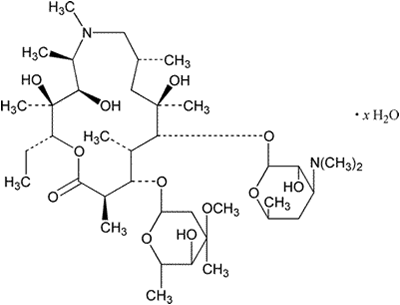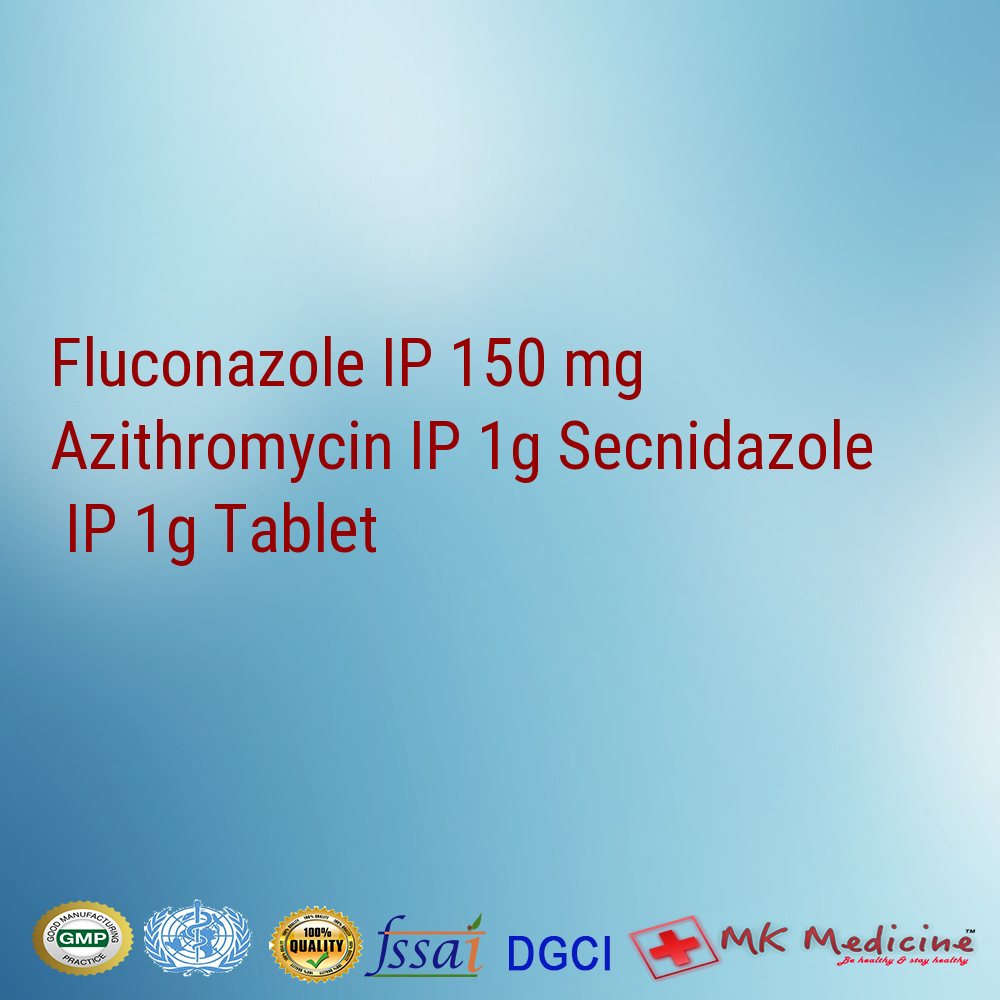Azithromycin is an antibiotic that fights bacteria. Azithromycin is used to treat many different types of infections caused by bacteria, such as respiratory infections, skin infections, ear infections, and sexually transmitted diseases.
Fluconazole is used to treat fungal infections, including yeast infections of the vagina, mouth, throat, esophagus (tube leading from the mouth to the stomach), abdomen (area between the chest and waist), lungs, blood, and other organs. Fluconazole is also used to treat meningitis (infection of the membranes covering the brain and spine) caused by fungus.
Secnidazole is a nitroimidazole anti-infective. Effectiveness in the treatment of dientamoebiasis has been reported. It has also been tested against Atopobium vaginae.
WHAT IS ATMOZETH-FS AND WHAT IT IS USED FOR?
This combikit is used as:
• Acute bacterial exacerbations of chronic obstructive pulmonary disease due to H.influenzae, M.catarrhalis or S.pneumoniae
• Acute bacterial sinusitis due to H.influenzae, M.catarrhalis or S. pneumoniae
• Community-acquired pneumonia due to C.pneumoniae, H.influenzae, M.pneumoniae or S.pneumonia
• Trichomoniasis
• Bacterial vaginosis
• Vaginal discharge due to Candidiasis
• Infections or mixed infections with chlamydia and neisseria
Why is this medication prescribed?
Azithromycin is used to treat certain bacterial infections, such as bronchitis; pneumonia; sexually transmitted diseases (STD); and infections of the ears, lungs, sinuses, skin, throat, and reproductive organs. Azithromycin also is used to treat or prevent Disseminated mycobacterium avium complex(MAC) infection [a type of lung infection that often affects people with human immunodeficiency virus (HIV)]. Azithromycin is in a class of medications called macrolide antibiotics. It works by stopping the growth of bacteria.
Antibiotics will not kill viruses that can cause colds, flu, or other infections. Fluconazole is used to treat fungal infections, including yeast infections of the vagina, mouth, throat, esophagus (tube leading from the mouth to the stomach), abdomen (area between the chest and waist), lungs, blood, and other organs. Fluconazole is also used to treat meningitis (infection of the membranes covering the brain and spine) caused by fungus. Secnidazole is a nitroimidazole anti-infective. Effectiveness in the treatment of dientamoebiasis has been reported.
MK Medicine is a leading pcd franchise provider, contract manufacturer and hospital supplier of WHO-GMP certified Fluconazole IP 150 mg Azithromycin IP 1g Secnidazole IP 1g Tablet
• You should not use this combikit. if you have ever had jaundice or liver problems caused by taking this medicine. You should not use azithromycin if you are allergic to it or to similar drugs such as clarithromycin, erythromycin, or telithromycin.
• You may need to take only one dose of fluconazole, or you may need to take fluconazole for several weeks or longer. The length of your treatment depends on your condition and on how well you respond to fluconazole.
Kit contains three chemotherapeutic agents Azithromycin, Secnidazole and Fluconazole. These 3 drugs do not cause drug interaction when given together on the same day concomitantly.
Contraindicated in patients with known hypersensitivity to Secnidazole, Fluconazole, Azithromycin
The drug should not be administered during the first trimester of pregnancy or lactation.
The majority of side effects are mild and transient:
Azithromycin Anaphylaxis, angioneurotic edema, diarrhea, nausea, cramping abdominal pain, flatulance, vomiting, headache, and dizziness Fluconazole Headache, nausea, abdominal pain, diarrhea, dyspepsia, dizziness, taste perversion, and rarely angioedema and anaphylactic reaction. Secindazole Nausea, gasrtigia, change of taste, metallic taste, stomatitis, urticaria, rashes, leucopenia, rarely vertigo, moderate neurological and digestive troubles.
Disclaimer:To be taken only after consulting with the doctor.
PHARMACOLOGY
Mechanism of Action
Azithromycin acts by binding to the 50S ribosomal subunit of susceptible microorganisms and, thus, interfering with microbial protein synthesis. Nucleic acid synthesis is not affected. Azithromycin concentrates in phagocytes and fibroblasts as demonstrated by in vitro incubation techniques. Fluconazole is a highly selective inhibitor of fungal cytochrome P450 sterol C-14-a-demethylation. Mammalian cell demethylation is much less sensitive to fluconazole inhibition. The subsequent loss of normal sterols correlates with the accumulation of 14-a-methyl sterols in fungi and may be responsible for the fungistatic activity of fluconazole.Secnidazole is the first nitroimidazole to offer a 3-day antiprotozoal activity from one single dose. With its prolonged half life, (secnidazole) offers an effective treatment and thus ensures improved patient compliance because of the short duration of treatment with excellent therapeutic efficacy.
Pharmacokinetic and Pharmacodynamics
Fluconazole has been preferred first line therapeutic choice in vaginal candidiasis.. It has been shown to exhibit single dose efficacy, and infections treated with fluconazole show low rate of recurrence rate, since the drug eliminates rectal infections. Azithromycin has demonstrated excellant cure rates (95-100%) in the management of chlamydial and gonococcal infections with single dose therapy as compored to multidose therapy of antibiotics. Secnidazole has been relatively new anti-fungal that has demonstrated impressive therapeutic efficacy in the clinical setting. The longer half-life (17 hrs) of secnidazole compared to that of tinidazole (13hrs) means that the drug has a longer duration of action against causative organisms.
INTERACTIONS
Azithromycin Magnesium and aluminium containing antacids reduce the peak serum levels. Possible occurence of ergotism following concurrent use with azithromycin Co- administration of Digoxin or cyclosporine requires the monitoring of their serum levels. Fluconazole Azole antifungals increase the cyclosporine levels by slowing the metabolism of the drug. Fluconazole increases the concentration of phenytoin by inhibiting the drugs metabolism. The AUC of phenytoin was increased after 16 days of 200mg of fluconazole The concentration of cifabutin was increased to two-fold by fluconazole Administration of fluconazole to diabetic liver transplant patients on tacrolimus showed an increase in tacrolimus concentration and reversible nephrotoxiocity The bleeding time was increased in patients on warfarin Mean plasma clearance of theophylline was decreased by fluconazole Concentraion of zidovudine was increased following co-administration of fluconazole. Fluconazole may increase the concentration of oral anticoagulants Secnidazole A disulfiram-like reaction has been reported following ingestion of alcohol during and up to 24 hrs after theapy with secnidazole and hence alcohol should be avoided. Secnidazole may potentiate the effect of warfarin and should not be administered to patients with a history of bleeding disorders.
• Tell your doctor and pharmacist if you are allergic to fluconazole, other antifungal medications such as itraconazole (Sporanox), ketoconazole (Nizoral), posaconazole (Noxafil), or voriconazole (Vfend), any other medications, or any of the ingredients in fluconazole tablets or suspension. Ask your pharmacist for a list of the ingredients.
• Tell your doctor if you are taking astemizole (Hismanal) cisapride (Propulsid) erythromycin (E.E.S., E-Mycin, Erythrocin); pimozide (Orap), quinidine (Quinidex), or terfenadine (Seldane) (not available in the US). Your doctor will probably tell you not to take fluconazole if you are taking any of these medications.
Azithromycin should not be used in patients with pneumonia who are judged to be inappropriate for oral therapy because of moderate to severe illness or risk factors such as any of the following:
• patients with cystic fibrosis
• patients with nosocomial infections
• Patients with known or suspected bacteremia
Azithromycin is a macrolide antibiotic with high stability at acidic pH, long half-life, and favorable effectiveness against a range of organisms In addition, it interferes poorly with the cytochrome P450 system in vitro, limiting side effects related to drug interactions.

Fluconazole the first of a new subclass of synthetic triazole antifungal agents, is available as tablets for oral administration. Fluconazole is designated chemically as 2,4-difluoro-α,α1-bis(1H-1,2,4-triazol-1-ylmethyl) benzyl alcohol with an empirical formula of C13H12F2N6O and molecular weight of 306.3. The structural formula is:

Secnidazole (α,2-dimethyl-5-nitro-1H-imidazole-1-ethanol) is an antimicrobical drug, and it is particularly effective in the treatment of amebiasis, giardiasis, trichomoniasis, and bacterial vaginosis. 
Clinical Data of Azithromycin
|
Pregnancy Category |
AU:B1 |
Legal Status |
US:Rxonly |
Routes |
Oral |
Clinical Data of Fluconazole
|
Pregnancy Category |
D (Au), C (U.S.) |
Legal Status |
S3/S4 (Au), POM (UK), Rx-only(U.S.) |
Routes |
Oral |
Important Notice:- The Database is still under development and may contain inaccuracies. It is not intended as a substitute for the expertise and judgement of your physician, pharmacist or other healthcare professional. It should not be construed to indicate that the use of any medication in any country is safe, appropriate or effective for you. Consult with your healthcare professional before taking any medication.


Amoxicillin IP 500mg Clavulanic Acid IP 125mg Tablet